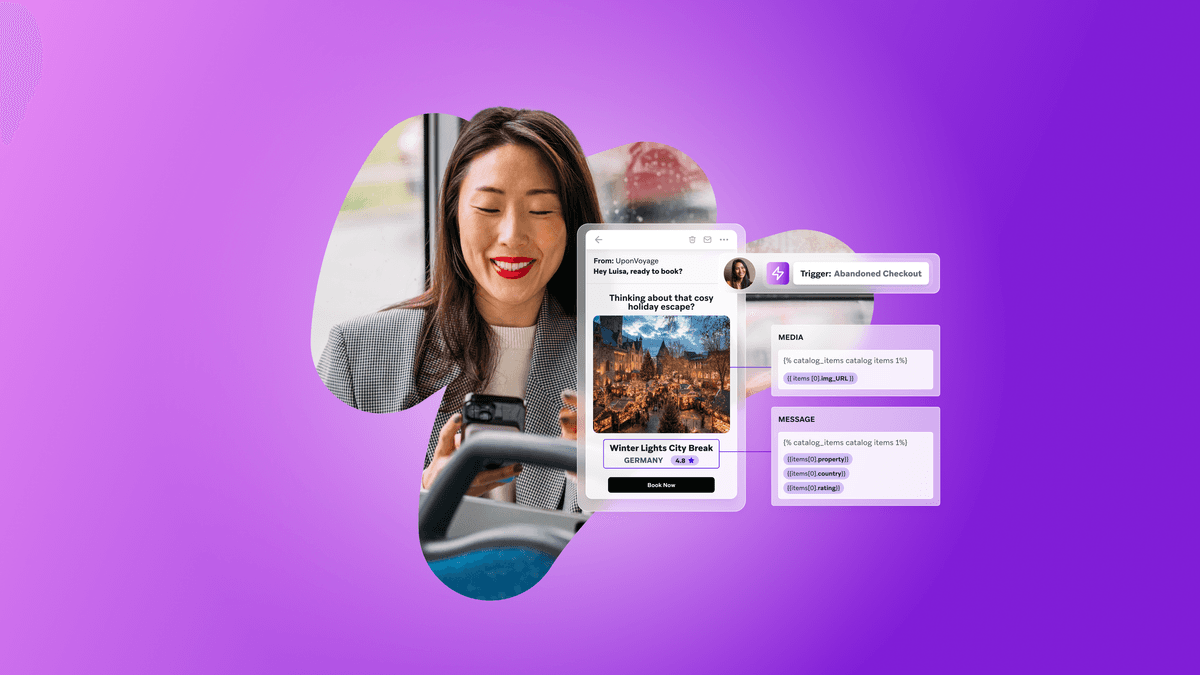6 Tips for Authentic Marketing That Pays Off
Published on April 07, 2016/Last edited on April 07, 2016/11 min read


Team Braze
One of the best tattoos I’ve ever seen was a waveform—squiggly lines representing audio—on the forearm of a salesman. The image represented a voicemail. “From my dad,” he explained. “It said, ‘just be yourself.’” If that story gave you a little squeeze in the heart, run with it. Embrace it from your professional self. Can you, as a marketer, take that guy’s dad’s advice to heart? The evidence says that it’ll boost your success with your customers, too.
“Being yourself”—that is, knowing who you are as a brand, and speaking from that place authentically in all communications with customers—can and will result in better connections with customers, and will almost always increase retention. Study after study proves that customers prefer brands they perceive to be authentic and honest; including a 2014 study from global PR firm, Cohn & Wolfe.
That study surveyed more than 12,000 users. The results were overwhelmingly conclusive. The #1 “quality or behavior” customers want to see from brands is “communicating honestly about products and services.” The runners up were “Not letting customers down,” and “Acting with integrity at all times.” Acting with integrity was valued over innovation and bringing unique products to market.
“Just be yourself” is easier said than done
Being oneself, or practising authenticity with ease, is something some folks get right from an early age. But the majority of us get there through years of trial and error. If we’re lucky, we eventually come to reside comfortably in a version of ourselves we grow into as adults. Most of us know intimately the challenge that is “just being ourselves.” How then can we take a brand, a business, a company, and seek to represent it?
Double negative alert: don’t be inauthentic
Inauthenticity in relationships happens when we change ourselves based on how we wish to be perceived by other people. The chief trait of the inauthentic individual also happens to be how today’s marketers spend most of their waking hours: analyzing how we come across to others, and reshaping our image for more appeal, based on what we think they want (whoever they are—in our case, customers and potential customers).
Marketers spend a lot of time doing something that people associate with inauthenticity.
So how do we hop off that train?
I spoke with Bryan Taylor, Creative & Strategic Alignment Director and founder of Drawn, a brand development agency based in Oregon. Drawn has a focus on crafting authentic brand stories through what they call “meaningful engagements.” They aim to build brand and company experiences to which fans, patrons, and consumers are all naturally drawn. Together, he and I narrowed down six basic principles to help guide digital marketers in the mobile space toward their own authenticity.
1. Don’t chase. Instead, attract.
“There are two schools of thought,” says Taylor. “The old school of thought centers around the idea that I need to know my customers in order to constantly be changing my offering to match what they’re looking for. We call that ‘chasing.’ Chasing for attention as consumer habits change. In this case, brands try to change to match who they are to what they think the consumer wants. Instead, in the newer school of thinking, we attract. Consumers look for brands that already speak to who they are.”
It’s still important to pay attention to customer habits, of course, so brands can play in the right spaces, and reach their target market. Once you’re there, though, you don’t have to constantly be changing who you are.
The most interested, most valuable customers will come to you if your brand has an internal and consumer-facing alignment, so that, “when the customer does engage, the message is one unified thing. If you look at brands who are successful, you’re already experiencing this from them.”
2. Be patient with internal company changes
Taylor is clear to point out that creating an attract-rather-than-chase marketing culture can take time. Not everyone will have patience for a strategy shift of this magnitude. But he believes, it’s “the more sustaining direction to go.”
Marketers should have empathy for the decision makers (like their bosses) who have bottom line goals that might make strategy shifts a tall order. They should also “have the conviction to know that this way of doing things is better in the long run. Hold those two emotions side by side,” and be patient. “Advocating for a wholesale shift might not do anyone any good,” Taylor adds. “Shoot for slow shifts” that hint at change with an eye on long-term strategy realignment.
3. Listen to your customers well
One of the greatest qualities of a truly authentic individual will be their capacity to listen well. Can you listen to your users as you might to someone you were really interested in? Can you listen, and hear, without worrying about yourself? In a recent survey, more than 50% of consumers said they’re likely to abandon a brand if the feedback they leave in-app goes unacknowledged. Consumers want to feel like you’re listening!
Consider your brand in the wider context of the customer’s day
Taylor says the crux of listening well, in his experience, is about understanding how your brand fits into the context of the customer’s life. The engagement marketer sending an email, for example, should have a sense of, “What is the user doing as they’re going about their day when the email will be sent? How will they receive it? What pressures are they under at the same time?” Then, says Taylor, “write something that reflects that understanding.”
The good news is that modern marketing solutions make this more possible than ever.
Invite the customer to participate
Inviting participation is a good way to engage with the customer. The customer just has to find that, when they do heed a call to interact with the brand, the same spirit of the call to action is upheld in the company’s response.
For example, Taylor shared a story of working with a local credit union. They decided to promote a great temporary rate on auto loans by asking users to share their “first car” stories. Once users shared their stories, the company had to acknowledge those stories in some way so that the stories weren’t shared in a vacuum.
“You give the customer a floor, so to speak. It happens naturally in social media,” says Taylor. “The reality is, the customer already has the floor. Not every company is willing to admit that. They want to keep the microphone, but the reality is, they’re not actually holding it.”
Companies want to keep the microphone—but the customer already has the floor.
4. Know your brand
Almost as elusive as the phrase “just be yourself” is this idea of knowing oneself. Knowing your brand can be just as tricky. Happily, Taylor has a one word curative: Immersion.
Internal immersion
“It can be pretty shocking to see how little workers know of what their coworkers actually do,” he says. He’s a proponent of the idea that to drive the internal cohesion required for authenticity, each department in a company should have a fairly intimate sense of what’s required of their colleagues on other teams. This is especially important for marketers who are on the front lines of representing who their company is and what they do.
Craft a new mission/vision statement
Taylor also spoke about re-creating the company mission statement. We wrote about vision statements back in January, in a piece about brand stories. Our expert, Tamara McCleary, said back then that brand vision statements are usually “all wrong” and mostly need to be rewritten based on the “soul of the company.” Taylor echoed this sentiment almost verbatim.
“Everyone has a mission/vision statement, and most of them are exactly the same,” and essentially meaningless, he says. When Drawn works with a company on defining their brand personality, they rework the mission statement. “We describe it as their ethos or heart/soul. We try to not use the same terminology that everyone uses in their mission statement, and truly try to figure out who they are at a heart and soul level.”
That document (which should never be more than a single page) can become a decision-making document. Companies can point to it when there’s doubt about a course of action, or when a campaign needs honing or refining. It can also “remove personal conflict that can arise during decision making,” says Taylor.
Sound good on a press release? Scrap it.
Andy Sernovitz is the author of Word of Mouth Marketing: How Smart Companies Get People Talking. Where marketing ethics are concerned, Bazaarvoice.com calls him a “rabid purist.” In a short video, he says, “If it looks good on a press release, it is totally inauthentic, because real people don’t talk like marketers.” When in doubt, put your messaging through this authenticity quick-test and opt in favor of plainer, more direct language.
5. Admit your flaws
Most truly authentic people have no problem admitting it when they’ve made a mistake. “There are varying levels of transparency that people are comfortable with. More transparency fosters a more listening culture. It invites more honest feedback. Transparency and business go together,” says Taylor.
More transparency fosters a listening culture. Transparency and business go together.
Taylor shared a personal anecdote. “I just purchased a bed frame online. Nowhere was I able to discern how long it would take to arrive. Finally, I found out it would take three months. It’s ludicrous to think that this wasn’t disclosed anywhere. Then, there was nowhere on the site to leave a review to let other customers know. The only visible reviews were clearly filtered. The whole thing felt horribly inauthentic. The experience was so heavily curated, it felt outright dishonest.” Taylor ended up canceling his order. “I might have waited the three months if it were just disclosed, but because of their whole disguise, I went with another company that was more expensive and still took three months.”
Had the company disclosed the delivery schedule, he might have waited. If, when he contacted them, they had admitted their fault in not disclosing it, he might have waited. Likewise, if the very structure of the experience had been more authentic, he might not have taken his business elsewhere.
Admitting culpability, within reason, builds credibility. It shows respect for the consumer, demonstrates humility, and plain and simple, keeps it real.
6. Believe in your brand. Like, for real.
Not every job description promises a life of altruism. Some of us sling hash and sell widgets. So, how can we authentically cultivate a sense of pride for a brand whose major goals might not necessarily get us excited?
Mine the value
As Tamara McCleary suggested to us a few months ago, we can all find meaning in what we do by unearthing the deeper purpose or point behind the product or service we support. “Mine the values,” she counseled. What’s your brand story? What’s your company mission and vision? Where do people actually connect with whatever it is you have to offer? “Maybe the value is helping, maybe it’s serving. Whatever it is, it’s the touch. The connection. You haven’t found it till you can pinpoint where the customer will feel like their needs are being met.”
Work on cultivating your in-office culture
Taylor takes a similar tack from a different angle. He says, “Your internal brand is really important, and it needs to align with your external image. It needs to be felt and experienced internally, otherwise that message will fall flat.”
“Internal brand-building is largely overlooked,” he says. “Customers are attracted to an authentic experience, and so are employees. If you’re always pushing for something that doesn’t have a bigger story to it, or a bigger purpose to it, then it will be really hard to get people to manufacture a love for what they’re doing.”
That means doing a little internal marketing by teaching your team the value that your brand provides, and encouraging belief in it. “It takes good, strong leaders who understand that you have to market internally as well as externally.”
The biggest gift of authentic marketing
Once you do the work to attract instead of chase, to learn how to listen to your customers, to know your brand well and really believe in it, you’re likely to find that the real gift of authenticity—beyond better retention and more prolific sales—is a sense of freedom. You’ll no longer be in the struggle of trying to embody a brand personality that’s a mere construction.
As you become a more open company internally and with customers, as you come to fully know who you are as an enterprise, confidence will likely come to dominate your marketing process.
Be Absolutely Engaging.™
Sign up for regular updates from Braze.
Related Content
View the Blog
How behavioral marketing turns data into personalized experiences

Team Braze

How Braze supports exceptional customer engagement during Black Friday, Cyber Monday, and beyond

Todd Grennan

How to overcome messaging fatigue this holiday season
